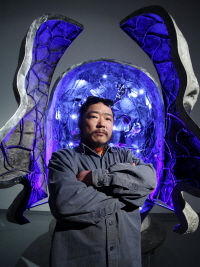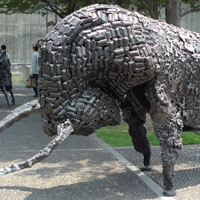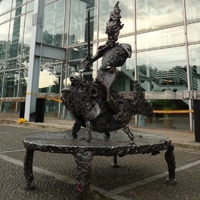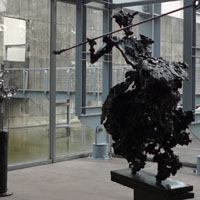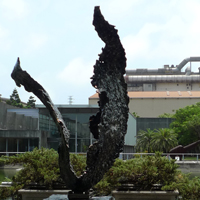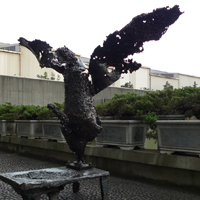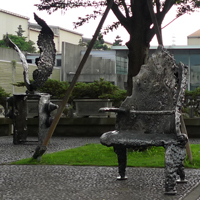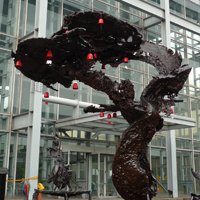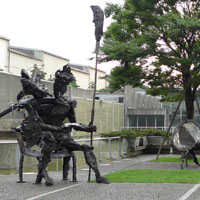The Truly Original Sculpture of Donghun SUNG
International exchange in contemporary art increased dramatically in the 1990s. Sculpture in Asia benefitted greatly and has steadily advanced since. Within this global movement, Korean sculptor Sung Donghun has manifested his own individuality through his artworks. In the catalogue titled Nomadism of Brain, published in conjunction with his solo exhibition in 2009, Sung revealed his thoughts on nomadism. He believes that nomadism means thinking without being bound by any kind of form and perception, and he has actively engaged in sculpture in diverse societies with mixed cultures. Thus, nomadism for Sung not only serves as a foundation for his ideas but is a specific means for his work. A good example is Into Brain, a typical sculpture that reflects Sung's consciousness. A skull of cement and stainless steel splits open to reveal what seems to be a network of neural circuitry inside that expresses how humans receive diverse stimuli from outside and process them. Sung's sculptures are quite singular in that he concentrates enormously on their insides. Many of his works are made to open and close, and he put symbolic things inside. The opening and closing of his sculptures makes their form and the meaning inside the form all the richer. The appearance of his sculpture from a distance is completely different from that when one is close.
Sung became famous in the Korean art world in the 1990s with his Don Quixote series. He broke away from the Don Quixote series in 1999, effectively breaking his mold and engaging in diverse forms of sculpture. It was actually already in the 1990s that Sung began to produce different types of works that express his thoughts about politics, society, and history, and the burdens and responsibilities of an artist toward society. However, he had done the Don Quixote series so extensively that Sung was widely misperceived as having done only that and nothing else. Even so, Sung's Don Quixote series is extremely varied in both form and materials used. Korean art critics have already long analyzed and accurately assessed Sung's Don Quixote series, so I will concentrate on how the Don Quixote series in his early years has influenced his later works from an artistic perspective. The overall formativeness and dignity of these works impart a feeling of power to viewers and seem to fill Sung's sculptures with dynamic energy. Even his works about sex manifest energy, vitality, and the basic instinct that humans have as living things.
It is very natural that various forms seen in Sung's works should be reminiscent of the classical Chinese book Shan Hai Ching ("The Classic of Mountains and Seas"). This book depicts numerous ancient Chinese monsters, which were created by people in their imaginations. It created new, fantastic figures by using parts of different animals interchangeably, and they resemble Sung's works. Sung's sculptures are of combinations of different objects, and many of them are combinations of various animals. None of them are combinations simply stacked or piled in tiers. His sculptures instead are in the form of weak objects supporting the heavy weight of the entire piece, addressing social issues in a serious way. Sung collects various objects in his everyday life, and his studio is packed with objects he has collected from everywhere. Thus, he has countless different shapes in his mind and can refer to any of them whenever needed for production of his artwork. Such being the case, we cannot say that Sung's sculptures are entirely created in his imagination, but it is obvious that his works are essentially products of his imagination. Throughout the world, imagination is a key word of contemporary art. Through imagination, an artist limitlessly expands the space of his artwork, and establishes his own identity as an artist. Sung often journeys to barren lands such as deserts to do his artwork. Deserts are not merely one type of space; they are places filled with adventure. In fact, Sung considers a desert even much more than that because it has romantic imagination. In such an extreme environment, Sung's energy for creation surges. This is what makes Sung's works so unlike ordinary works created in ordinary environments.
Sung's works are very exquisite in that they are a mix of different materials. He often uses very unusual materials such as lumps of scrap metal dumped by an ironwork. This kind of scrap metal is of matiere with a strong feeling of roughness and irregularity rather than ordinary pieces of steel of uniform size and volume, so it seems to be constantly moving and changing. This lump of scrap metal is an important element that makes viewers feel the passage of time when they are looking at Sung's works, which feel like very old artifacts as if they had been excavated from deep underground.
As a sculptor, Sung is very sensitive to the properties of materials. My first thought when looking at his works was strong contrast between materials. In other words, the hard and soft materials create a synergy effect instead of conflicting with each other. What is more, Sung gives symbolic meaning to the hard and soft properties of materials beyond merely making contrasts. In his works, hardness represent intrepidness, toughness, strong will, and determination, while softness symbolizes fantasy, imagination, beauty, and frailty. In general, the way an artist treats a certain material is based on how the artist perceives that material. If an artist gets a certain feeling from that material, it will determine the way the artist treats the material, and the final visual results, which reveal how the artist has dealt with the material, reflect the artist’s individuality.
Sung and his artworks share some features in common with Sui Jian Guo, a very talented contemporaneous Chinese sculptor. Both started studying fine art and began their careers in the 1980s, and each established himself in the art world at home in the 1990s. (Sung in Korea and Guo in China.) In the first decade of the 21st century, both sculptors began doing richer work. Sung Dong-hun and Sui Jian Guo both think material is basic to sculpture. Sui Jian Guo produced a number of sculptures made of stone and steel in the early 1990s, as can be seen in his works of stone surrounded by steel. In nearly all of Sung’s works, the contrast between steel and stone produces optimum effects, and the effects of steel with wood are also outstanding. While Sui Jian Guo generally works on conceptual forms taking advantage of the material itself, Sung Dong-hun gives specific form to material without making contrast between the materials themselves. If Sui Jian Guo does not generally give a specific form to his sculpture, Sung Donghun gives a certain form to his sculptures without completely giving up formativeness. Installation elements are always important in Sung's works, though we cannot define Sung's works as installation. His works still have the essence of sculpture.
Sculpture has changed greatly over the past several decades. Many sculptors felt that there were limits to the concept of sculpture itself and have strived to expand the realm of sculpture. As a result, many sculptors’ works are already beyond sculpture. Explorations by sculptors into the outside world have garnered great results, but study on sculpture itself seems to have become somewhat neglected. Sung, on the other hand, has made tremendous efforts to explore sculpture itself as well as other domains. Sung has never let exploration of the world outside of sculpture to cause him to neglect study of sculpture itself, and this has in turn allowed him to advance remarkably in his works with respect to materials, forms, and the structure of sculpture itself.
Also noteworthy is a pedestal of Sung's sculpture. Of all pedestals in various forms accompanying all of Sung's sculptures, what I find most impressive is a semicircular one bent like a bow. Sung considers this semicircular pedestal as a mountain, which makes the pedestal look more dynamic, while stably supporting the upper part of the sculpture.
From a macroscopic perspective, I suggest that Sung Donghun strengthen the abstract elements in his future works. Strong abstract expression should improve the formativeness and perpetuity of his works by reducing the impression of stereotyped look that almost resembles the actual thing. When sculpture no longer needs to find what it should express from specific form and when the vitality contained in the form of sculpture itself becomes a yardstick to measure the quality of his work, Sung's works will be seen to be more original and more perfect. Then, the viewers will no longer be attracted so much by the animal-like shapes of Sung's sculptures but by the way the artist has addressed the form, that is, by how Sung has garnered energy from each part of his sculpture.
Sculpture tends to reflect economic development. Developed countries support sculpture very substantially. Korea also backs sculpture strongly, but Sung has produced many sculptures on commission all over the world. Sung considers the environment of the site on which the sculpture is to be installed very important, so he always goes to the site and does the work there. In other words, the environment of the worksite is another important factor in Sung’s creative process, and his works are all that much more impactful because they are in great harmony with the surroundings. Of all Sung's works, I am most impressed by Sound Tree. It is a really beautiful piece, even more beautiful than the real trees surrounding it. When the wind blows, the thousands of wind bells hanging on the tree make a beautiful sound, inviting the viewers to enjoy the beauty of nature and even to feel the joy of creation of artwork. At night, Sound Tree shines dazzlingly with lighting and fills the viewers with a kind of impression that they have found hope in darkness. As if a belief in our life, Sound Tree gives great consolation and encouragement when we feel hope is lost. In China, there is a saying 'An artwork is the artist him/herself,' which means that the philosophy, the stance and the view of the world of the artist are always reflected in his artwork. According to this Chinese saying, Sung Donghun is always shining bright, clean, and honest.
I was lucky enough to have an opportunity to visit his studio in Korea. I was surprised and happy to see his diverse works placed among plants growing tall. The place in which he lives and works is ensconced by beautiful mountains and clear water. To me, an art critic from China, the place was very familiar. Isn't this the kind of place that ancient Chinese artists considered ideal? For the Chinese, the highest perfection humans can attain after mental training is becoming one with the universe.
Korean and Chinese sculptors face similar situations. Both should find their own unique style within the global context of contemporary art. They need to maintain the characteristics of Asian art within the contemporaneous trend of global art. Asian art should also find a way to contribute to world contemporary art with its own uniqueness, while trying to become fully involved in the international system of contemporary art. And now, sculptor Sung Donghun is showing the uniqueness of Korean sculpture to the world.
Duan Jun
more
NOMADISM IN TYPE, NOMADISM IN CONSCIOUSNESS
Don Quixote, the portrait or the portrait of an artist. Image of Don Quixote is what sculptor Sung Donghun reminds us of first. Don Quixote served as a momentum for him to get into the mainstream and various versions of Don Quixote have been made intensively especially since 1990's. Image of Don Quixote and nature of the mainstream, however, do not seem to conform or go well with each other, Don Quixote has been known as a representative character of anti-mainstream symbolizing dream and fancy, unreality and surrealism, satire on society, critique and even madness. The mainstream of sculpture system may have become flexible enough to embrace such unreality and insanity or may have quietly missed this temperament implicitly. As a result, at least in appearance, the sculptor's strategy to break through the mainstream of stubborn art with senseless, reckless and ignorant character worked anyway and it seems wise enough. (It would be more accurate expression to say that he was faithful to instinct rather than he was wise. Don Quixote has therefore marked as the self-portrait of the sculptor breaking through the times, and even positioned as a portrait of all the artists who are standing against the system. Moreover, this portrait easily gains our sympathy because the character awakens irrationality and madness in our deep inside, which is usually hold down as an abnormality being compared with normality of the system.
Don Quixote rides a horse in novel, but the sculptor's Don Quixote rides a cow from time to time. From the point of the history of civilization, horse connects with nomadic tribe and cow does with agricultural nation. Cow was an essential for farmers, and moreover was endowed with even religious meaning in traditional oriental society. For instance, in Hinduism, cows are considered as sacred animals and, in the Zen Sect of the Buddhism, cows are known as the metaphor of the Sibwoodo. Cows, that is, represent a symbol of human nature being immanent in our heart. Sibwoodo describes ten steps of course man is searching for his true character which is represented as a cow and It comprises mythical epos in it, It would not be coincident that all the cows created by the sculptor are not tame but are reckless and wild cows. It is natural that true character is what has to become tame rather than what was tame already. In this way, with a character of clown riding on a wild cow, the sculptor breaks through the era of irrationality and madness and get his true character as well(or at least to aim).
Being transformed into a cow decorated with small and tiny artificial flowers, his cow became tame and beautiful significantly in his recent works. Nature of the sculptor has become supple recently? Probably yes. (the sculptor, cow and Don Quixote are all the same.) It is far from the cow with bone of scrap metal and body of cement, which was born from a pile of industrial waste. Judging from the change of material, the sculptor's works seem to have already touched field of the Pop-art and Kitsch developing from Neo-realism and Junk-art.
Head, the kaleidoscope of consciousness. What is inside people's head? Sometimes we wonder what the hell people are thinking of. Andre Malraux says everybody has materials of aesthetic sense in his or her mind; he called it as the
Eroticism, desire, as a type of nature. Sculptor's work is as direct and honest as faithful to the nature. Repressed desire, especially sexual desire, is not the exception, either and he is not hesitating to express. Eros is the theme of a recent giant reversed triangle shape of sculpture. This sculpture is a kind of reproduction of a couch and a similar work was once introduced before already. Lining of leather cushion is put on metallic body of the sculpture and we can sit in it actually. Concave shape of it looks similar to women's panties and bloomy bud. Some people remind shape of this sculpture of bull's head.
List of the objects naturally associated with the structure of the reversed triangle alludes to sexual relationships between men and women (for instance, like the relationship between Zeus transformed into a bull and
Artificial garden, care for nature and ecology. The sculptor creates a kind of artificial garden in the exhibition space. Trees, insects such as ants and beetles and reptiles like snakes are organically in good harmony. Tree could be the center of these sculptures, with its huge scale and the symbolic meaning of myths and magic, it has been one of the artist's main materials. As we are aware, tree is a typical symbol of nature and it symbolizes production and life due to its fruits. World-tree symbolizes origin of existence and tree emblematizes phallus to Freud. Because of these meanings of tree, trees have been transformed to various types in his recent works such as iron tree, structural works in the form of tree borrowed from the format of a kind of the similar excavation project and the Sound-Tree exhibited in the 2007 World Ceramics Biennale. In the excavation project, the artist dig a big hole in the form of trees deep in the earth and fills with cement inside later, He digs up the structure again in certain days like the case of excavation of ancient artifact or large fossil in archaeological research. The Sound-tree is a tree sculptures which obtained popularity. After creating sculpture in the form of a tree with stainless steel, he hung about 2,000 pieces of porcelain wind-bell on every branch. Trembling in the breeze, these wind-bells make a sound and harmony of sound made from the interaction of wind and wind-bell is almost fantastic.
The sculptor's work, in this way, is developing from the fixed form of sculpture to other forms of sculptures covering power (Kinetic Art), sound (sound art) and light (light art). Reproduction of a deer and a goat is the case the artist introduced light in his works. Lights are equipped with a sculpture made with many small glass beads connected each other and, due to the light transmission properties of glass bead, it produces quite and fantastic atmosphere. This sculpture and the artificial flowers decorating the Flower-Cow hint that the sculptor's work is changing and evolving regularly. That is, they illustrate another point of formative possibility crossing the assembly and the dissolution together with awareness of organic relationships between the whole and the parts as is the case that repeat of a single unit finally creates a single structure. There must be a momentum that the sculptor introduced a series of these works with an idea on the natural materials shown as trees, insects and animals and the idea on an artificial garden where the natural materials are in good harmony in, it probably seems to be caused by the Desert Project. The Desert Project, at least, must have influenced him on the process of expansion of material and changes in consciousness in any way and it can be considered as the momentum therefore. The International Desert Project which started first in 2006 was in progress in the way of doing works in a few deserts around
We feel sympathy for a kind of nomadism from this interest in natural material and ecology and from the Desert Project as a process to practice. Nomadism means to the sculptor practical moving abroad for various foreign projects, nature friendly and ecological meaning of practice logic of life and, most of all, the nomadism in consciousness. A phase of it can be seen from a kind of pumpkin sculpture work. Pumpkin may seem at first a little bit strange but it was come out of practical and concrete logic of life and its process as it was cultivated in the artist's space used for both studio and home. It has something in common with that Don Quixote is representing a little crazy character, but it is working as a powerful mechanism to break through crazy and absurd time. Anyway, it is true that the pumpkin and its support which looks like a foot of ritual vessel and person's heads hung on every edge of the pumpkin look strange. Besides, this strange looking sculpture is also rotating swayingly. Combination of heterogeneous things or meetings of unexpected things are shown but it is not new to his works. There could not be harmony without disharmony and friendliness without unfamiliarity. Disharmony is the principle precedent of harmony and friendliness comes from unfamiliarity. As nomadism in type and nomadism in consciousness are working as practice logic to support the artist's work, Sung Donghun's future work will surely head for another new point.
Kho, Chung-Hwan (art critic)
more






